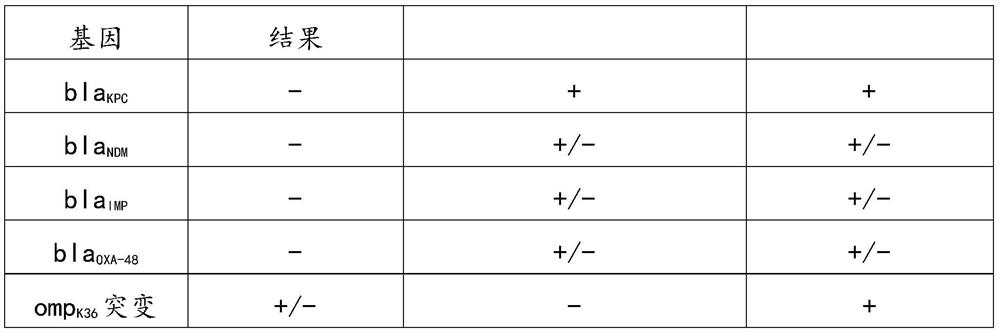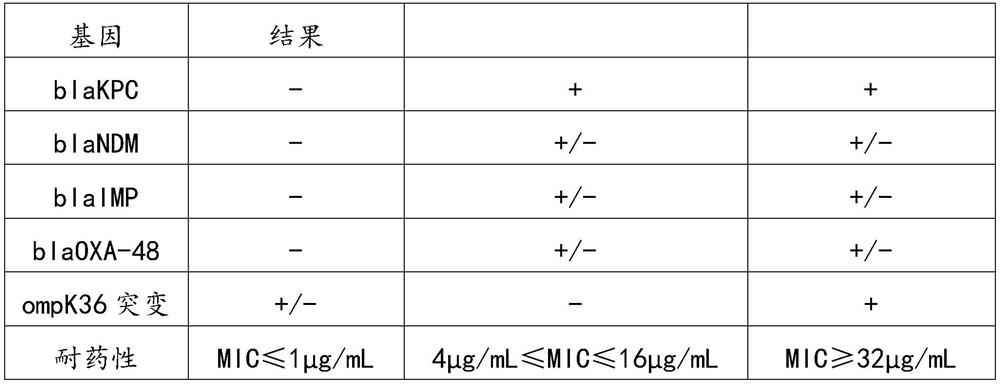Method for rapidly detecting drug resistance of klebsiella pneumoniae to imipenem through real-time fluorescent PCR (polymerase chain reaction)
A Klebsiella imine and real-time fluorescence technology, which is applied in biochemical equipment and methods, and microbial measurement/inspection, can solve the problems of cumbersome methods, poor accuracy, and easy contamination, and achieve high throughput , fast speed, and the effect of shortening the detection time
- Summary
- Abstract
- Description
- Claims
- Application Information
AI Technical Summary
Problems solved by technology
Method used
Image
Examples
Embodiment 1
[0077] Example 1: Design and screening of primers and probes
[0078] Search and download blaKPC, blaNDM, blaIMP, blaOXA-48 gene sequences and ompK36 mutant sequences through NCBI database, BLAST alignment, select specific conserved fragments, and use Primer Premier 5.0 to design primers and probes.
[0079] Primers and probes were synthesized and purified by Platinum Biotechnology (Shanghai) Co., Ltd. The probe is synthesized with fluorescent labeling at both ends. The fluorescent reporter group labeled at the 5' end of the probe is FAM, and the 3' end is labeled with a non-fluorescent quencher group TAMRA. After the synthesis of primers and probes, through a large number of test screening and combination testing, the detection primers and probes with sensitivity meeting the requirements are obtained.
[0080] The screened real-time fluorescent PCR primers and probes are:
[0081] blaKPC forward primer: CGATACCACGTTCCGTCTGG
[0082] blaKPC reverse primer: GCCATACACTCCGCAGG...
Embodiment 2
[0096] Example 2: Sensitivity and specificity detection of real-time fluorescent PCR
[0097] In this embodiment, 259 strains of Klebsiella pneumoniae isolated from clinics in Lishui Central Hospital were used as test samples. Specific steps are as follows:
[0098] 1. Template preparation: Scrape an appropriate amount of sample colonies from the Columbia blood agar plate and dissolve in ultra-clean water; heat at 100°C for 10 minutes, centrifuge at 12000r for 5 minutes, and take the supernatant as a template.
[0099] 2. PCR amplification of bla KPC 、bla NDM 、bla IMP 、bla OXA-48 and omp K36 The full-length sequence of the mutation is sequenced using first-generation sequencing technology to confirm whether each sample carries the above DNA sequence.
[0100] Of the 259 strains, 42.1% did not carry bla KPC 、bla NDM 、bla IMP 、bla OXA-48 , 24.3% carry bla KPC without omp K36 Mutated sequence, 24.7% carry bla at the same time KPC with omp K36 mutant sequence.
[01...
Embodiment 3
[0103] Embodiment 3: Confirmation of result judgment criteria
[0104] The test samples used in this example are the same as in Example 2, and the result interpretation standard is determined by comparing the real-time fluorescent quantitative PCR results with the drug sensitivity results. Specific steps are as follows:
[0105] The MIC values of imipenem in all 259 samples were tested using the Wenzhou Kangtai Drug Sensitivity Panel. Comparing the imipenem susceptibility results of each sample with the gene carrying situation determined in Example 2, it was found that: bla KPC 、bla NDM 、bla IMP 、blaOXA-48 98.2% of all negative bacterial strains were sensitive; bla KPC positive while omp K36 Mutation-negative strains were all drug-resistant, of which 4μg / mL≤MIC≤16μg / mL accounted for 96.8%, and MIC≥32μg / mL accounted for 3.2%; bla KPC The MIC values of the double-positive strains with porin ompK gene mutation were all greater than 16 μg / mL, and 89.1% of the strains had...
PUM
 Login to View More
Login to View More Abstract
Description
Claims
Application Information
 Login to View More
Login to View More - R&D
- Intellectual Property
- Life Sciences
- Materials
- Tech Scout
- Unparalleled Data Quality
- Higher Quality Content
- 60% Fewer Hallucinations
Browse by: Latest US Patents, China's latest patents, Technical Efficacy Thesaurus, Application Domain, Technology Topic, Popular Technical Reports.
© 2025 PatSnap. All rights reserved.Legal|Privacy policy|Modern Slavery Act Transparency Statement|Sitemap|About US| Contact US: help@patsnap.com



